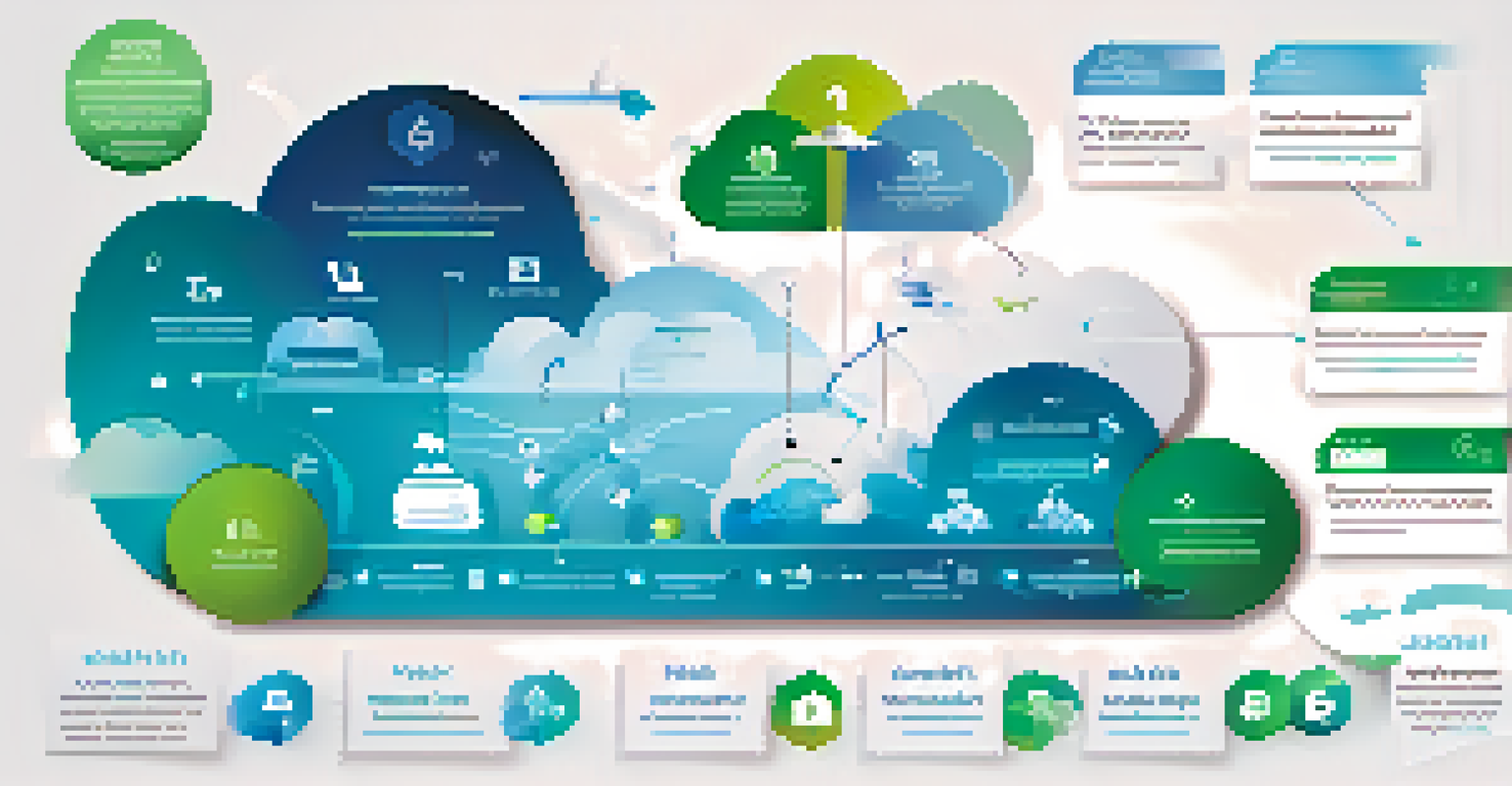Understanding Cloud Cost Management: Strategies for Savings

What is Cloud Cost Management and Why It Matters
Cloud cost management refers to the processes and tools used to monitor and control cloud spending. As businesses increasingly rely on cloud services, understanding these costs becomes crucial. Without proper management, companies can quickly overspend, leading to budget overruns and financial strain.
In the world of cloud computing, the only constant is change; adapting your cost management strategies is key to success.
Effective cloud cost management helps organizations optimize their cloud resources, ensuring they only pay for what they actually use. This is especially important in today's economy, where every dollar counts. By having a clear grasp of cloud expenses, businesses can make more informed financial decisions.
Moreover, cloud cost management isn't just about cutting costs; it's about maximizing value. By strategically managing expenses, companies can better allocate resources and invest in innovation, ultimately driving growth and improving their bottom line.
Identifying Key Cost Drivers in Cloud Services
To effectively manage cloud costs, it's essential to understand what drives those costs. Common cost drivers include compute instances, storage, data transfer, and additional services. By identifying these elements, businesses can pinpoint areas for potential savings and avoid unexpected charges.

For instance, many organizations may not realize they are paying for unused or underutilized resources. Regular monitoring and analysis can help identify these inefficiencies. Tools that provide insights into usage patterns can be invaluable for tracking these costs and optimizing resource allocation.
Understand Cloud Cost Management
Cloud cost management is essential for optimizing spending and maximizing value from cloud resources.
Additionally, understanding pricing models—such as pay-as-you-go versus reserved instances—allows businesses to choose the most cost-effective options for their needs. This knowledge empowers organizations to make strategic decisions that align with their budget and usage requirements.
Implementing Budgeting and Forecasting Techniques
Budgeting and forecasting are crucial components of cloud cost management. By setting a clear budget for cloud spending, organizations can avoid overspending and keep their finances in check. This foundational step creates a baseline for measuring actual costs against projected expenses.
What gets measured gets managed. If you can't measure your cloud costs, you can't manage them effectively.
Forecasting helps businesses predict future cloud costs based on historical data and usage trends. By analyzing past spending patterns, organizations can anticipate fluctuations in costs and adjust their budgets accordingly. This proactive approach enables companies to respond to changes in demand and usage.
Moreover, regular reviews of both budgets and forecasts ensure that organizations stay on track. By revisiting these figures frequently, businesses can make necessary adjustments and identify any discrepancies that may arise, keeping their cloud spending aligned with financial goals.
Leveraging Cloud Cost Management Tools and Software
Utilizing cloud cost management tools can significantly enhance an organization's ability to manage expenses. These tools provide visibility into spending patterns and resource utilization, making it easier to identify areas for improvement. Many solutions also offer automated reporting features, streamlining the monitoring process.
For example, software like CloudHealth or AWS Cost Explorer allows businesses to analyze their cloud costs in real-time. These tools can break down expenses by department, project, or resource type, providing valuable insights into where money is being spent. With this information, organizations can make informed decisions about resource allocation.
Identify Key Cost Drivers
Recognizing the main cost drivers, such as compute and storage, enables organizations to pinpoint savings opportunities.
Additionally, cloud cost management tools often come with budgeting and forecasting capabilities, enabling businesses to create more accurate financial plans. By integrating these tools into their operations, companies can proactively manage costs and optimize their cloud investments.
Optimizing Resource Allocation for Cost Efficiency
Optimizing resource allocation is key to achieving cost efficiency in cloud services. This involves right-sizing resources to match actual usage, ensuring that organizations aren't over-provisioning or under-utilizing their cloud infrastructure. Regularly assessing resource needs can help businesses avoid unnecessary expenses.
For instance, a company with fluctuating workloads may benefit from auto-scaling capabilities, which automatically adjust resources based on demand. This ensures that businesses only pay for the resources they need at any given time. By aligning resource allocation with actual usage patterns, organizations can significantly reduce costs.
Furthermore, adopting a cloud-native architecture can enhance efficiency. This approach involves designing applications specifically for the cloud environment, maximizing performance while minimizing costs. By leveraging best practices in resource allocation, businesses can create a more sustainable and cost-effective cloud strategy.
Encouraging a Cloud Cost-Conscious Culture
Fostering a cloud cost-conscious culture within an organization is essential for long-term cost management success. When all team members understand the impact of their cloud usage, they are more likely to make informed decisions that align with cost-saving goals. This cultural shift can lead to more responsible resource utilization across the board.
One effective way to promote this culture is through training and awareness programs. By educating employees on cloud costs and best practices, organizations can empower their teams to take ownership of their resource usage. Regular communication about spending trends and cost-saving initiatives can further reinforce this mindset.
Foster a Cost-Conscious Culture
Encouraging a culture of awareness around cloud costs helps teams make informed decisions that align with financial goals.
Additionally, establishing accountability measures—such as assigning budget owners for different departments—can help ensure that everyone is aware of and responsible for their cloud costs. By creating a culture of transparency and ownership, organizations can drive significant savings and make cloud cost management a collective priority.
Regular Review and Continuous Improvement Practices
Regular reviews of cloud spending and resource utilization are vital for maintaining effective cost management. By analyzing usage data and expenses on a consistent basis, organizations can identify trends, inefficiencies, and opportunities for further savings. This ongoing assessment is crucial for adapting to changing business needs.
Continuous improvement practices involve not just identifying issues but also implementing solutions and measuring their impact. For example, after optimizing resource allocation, organizations should regularly evaluate the effectiveness of these changes. This iterative process ensures that cost management strategies remain relevant and effective over time.

Moreover, fostering a mindset of agility allows organizations to quickly pivot and adapt to new challenges. As cloud services and pricing models evolve, being open to change and regularly reassessing strategies can help businesses stay ahead of potential cost overruns and make the most of their cloud investments.